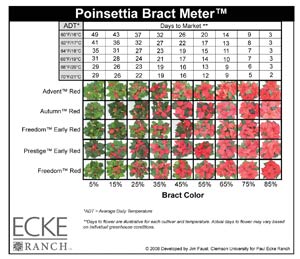8/1/2008
Growing Poinsettias Cold
Rebecca Siemonsma

With energy costs higher than ever, poinsettia profit margins are growing smaller. Cold-temperature production allows you to save energy, reduce costs and improve your profitability.
But be warned: Cold-grow production doesn’t mean simply turning the thermostat down. To produce a quality crop it’s imperative you follow certain cultural guidelines and choose from a list of varieties proven to perform well in colder environments. Avoid later varieties and those with a compact habit or smaller bracts. Cold growing can result in reduced vigor and a reduction in bract size, so varieties with good natural vigor and larger bracts work best.
Cultural Concerns
At cooler temperatures the plant’s metabolism and growth rate will slow, affecting nutrient and moisture uptake. Shoot and root growth will be affected, too. Considerations and adjustments for the roots and top growth include:
For roots:
• Maintain an average root zone temperature of 65F (17C).
• Irrigate late morning and finish by noon. Plants will be using less water.
• Monitor soil moisture levels closely.
• Less water uptake means less nutrient uptake. Monitor pH and EC closely.
• A preventative fungicide program for root-rotting pathogens is important.
• Check roots once or twice weekly and watch carefully for signs of stress or disease.
For top growth:
• Modify early growth regulator applications to reflect the early start. Cycocel alone, early in the season, will likely offer sufficient height control. Limit the use of B-Nine to propagation. Products containing paclobutrazol may be too strong.
• Don’t use an early morning negative DIF if growing with cold nights. Further reduction in temperatures will delay flowering.
• Reducing temperatures below 65F (17C) while plants are in the flower development phase (late September and early October) decreases the rate of development. Reducing temperatures too early will likely result in plants finishing after the target finish date.
• Provide good air circulation and adequate ventilation. And be sure to apply preventative fungicide applications for powdery mildew and botrytis.
Guidelines for Cold Production
• July and August: Add one to two weeks to traditional schedules.
• August and September: Take advantage of long days and build strong plants with fertilization, light and spacing. Average daily temperatures of 66-68F (18-20C) will prohibit early flower initiation. Don’t drop temperatures below 65F (17C) during this time.
• October 1: After flower initiation, reduce temperatures to no less than 60F (15C).
• November: Drop night temperatures to 55-60F (12-16C). Don’t drop temperatures below 55F (12C). On sunny days allow the greenhouse to warm to 75-80F (24-26C) to offset cold nights. On cloudy days maintain 75F (24C). The goal is to achieve an average daily temperature of 65F(18C).
• Mid-November to December: Plants are mature and ready to ship. You can drop temperatures more if the air in the greenhouse is dry and you monitor soil moisture levels closely.
Additional Pointers
Weekly photos of flower progression and good recordkeeping will prove useful when you’re evaluating the crop and making adaptations for future crops. You can upload your photos and notes to
OnTarget.Ecke.com. Free height tracking is also available.
When interpreting height-tracking graphs, you should expect earlier height against the standard curve and less height later in the production cycle.
Finishing
The Paul Ecke Ranch now offers a “cool tool” to help growers finish a cold-grown poinsettia crop on time. The Poinsettia Bract Meter, developed for Ecke by Jim Faust of Clemson University, allows you to reference a series of photos for six poinsettia varieties, then reference a corresponding temperature on the chart to know in how many days the crop will finish. You can then apply the appropriate amount of heat to hit target ship dates.
Get additional information on the cold grow technique at
http://www.ecke.com or post your questions on Ecke’s live bulletin board at
www.EckeRanchTechHelp.com.
Rebecca Siemonsma is Technical and Sales Support Manager for Paul Ecke Ranch, Encinitas, California.